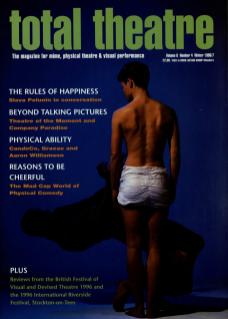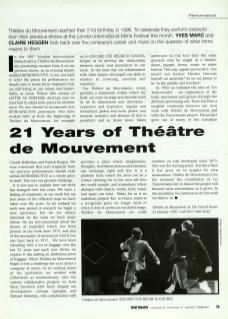In the 1997 London International Mime Festival, Théâtre du Mouvement are presenting excerpts from eight of our previous shows, in an evening simply entitled Retrospective. It was not hard to select the pieces for performance; we simply had to locate those fragments that are still living in our minds and bodies. Sadly, as Lucas Thierry (the creator of Lettre au Porteur) died last year we have had to adapt some pieces for another actor. We also wanted to incorporate into Retrospective performers who have worked with us from the beginning of Théâtre du Mouvement, for example Claude Bokhobza and Patrick Borgne. We were concerned that each fragment from our previous performances should exist within Retrospective as a whole piece in itself. This was our greatest challenge.
It is not easy to explain how our work has changed over the years. We have a feeling of continuity in our work but are also aware of the different steps we have taken over the years. As we embark on each new period of research we begin a new adventure but we are always informed by the work we have made before. We are still passionate about the theme of animality which has been present in our work since 1975, and also of the musicality of movement which you can trace back to 1977. We have been travelling with a lot of luggage over the last 21 years and each new theme we explore is like adding an additional piece of baggage. When Théâtre du Mouvement began it was a challenge for us to direct a company of actors. As we worked, many of the performers we worked with influenced us tremendously. Also the various collaborative projects we have been involved with have shaped our development. George Aperghis and Richard Dubelsky, who collaborated with us on Encore Une Heure Si Courte, helped us to develop the relationship between music and movement in our work. In the same way our collaboration with Alain Gautre developed our skills in relation to clowning, emotion and narration.
For Théâtre du Mouvement, mime provides a framework within which the body can exist on stage and describe itself in all its dimensions and directions – expressive and impressive, organic and formalised, global and local, plastic and musical, narrative and abstract (if this is possible!) and so many more. Mime provides a place where imagination, thoughts, movement process and emotion can exchange, fight and live. It is a platform from which the actor can be a creator carrying his or her own self into the world outside, and somewhere where dialogue with objects, words, texts, music and space can exist. Mime for us is an ambitious project! But in France mime as a recognised genre no longer exists or when it does it carries an outdated image. Théâtre du Mouvement are really interested in the fact that the same spectacle may be staged in a theatre, dance, puppet, clown, music or mime festival. This may appear provocative, but wasn't our teacher Étienne Decroux himself an anarchist? So we are proud to be 'in the middle and nowhere'.
In 1992 we initiated the idea of 'Les Transversales' – an exploration of the body, movement and gesture through the different performing arts. There has been a tangible continuity between our own work with Théâtre du Mouvement and with the Transversales project. The project grew out of many of the European contacts we had developed since 1975. This was the starting point, but since then it has gone on to acquire its own momentum. Théâtre du Mouvement is for the moment the coordinator of Les Transversales but in future the project will become more autonomous as it grows. In the meantime we continue to do the work we believe in.

